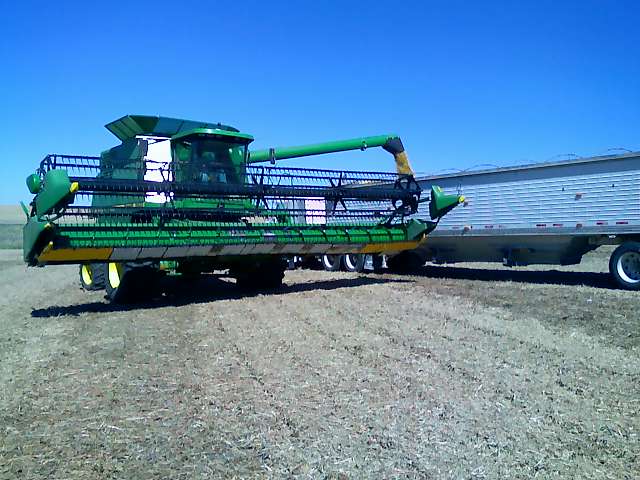August 28, 2017

By Dr. H. Mark Hanna, Iowa State University
Although generally good, corn and soybean crops are quite variable across Iowa as harvest season approaches. Spotty rainfall, in many cases too little but in a few cases too much, along with sandy or clay soil spots, and temperature extremes or storms have resulted in varying ear, and bean pod and stalk sizes, both among nearby fields and in some cases within fields or even individual rows. Such variations put a premium on combine adjustment this fall.
Proper adjustment can only be accomplished by taking time to measure and observe grain loss and quality. Combine grain losses can be held to one bushel per acre or less if the crop is standing reasonably well. One bushel loss equals two corn kernels or four soybeans per square foot on the ground. Grain quality is evaluated by inspecting harvested grain in the tank, looking for splits in soybeans, and cracked or damaged seed coats in corn or soybeans.
Losses occurring at the head can be separated from losses of the entire combine by stopping the combine and backing up several feet to look for losses on the ground traversed by the head, but not the rear of the combine. How to measure losses can be found in PM 574 Profitable Corn Harvesting and PM 573 Profitable Soybean Harvesting. Field studies show 90% of soybean loss and 60% of corn loss typically occur at the head with proper threshing and separating adjustments.
Head
Corn:
Ear diameters in some fields are smaller than normal. The gap between deck plates above snapping rolls (1.25 inches in normal conditions) should be narrow enough to avoid shelling kernels on the ear but yet wide enough for stalks to be pulled through without wedging. Stalk roll speed should be matched to ground speed and ear savers (at the bottom of stalk rolls) in good condition to hinder ears bouncing from the head.
Soybeans:
Research identifies the cutterbar as most responsible for soybean losses, but reel speed and position, and cross-auger operation can also affect losses. Ensure cutterbar sections are sharp, in register with guard positions, and held firmly against the guard with hold-down clips. The reel centerline is normally about 8-12 inches in front of the cutterbar, with height adjusted so that reel finger tips are no closer than about two inches to the flexible cutterbar when at its highest position. Reel speed index (ratio of peripheral reel speed to combine travel speed) is normally about 1.25 (25% faster reel than ground speed) but may be up to 2.0 (twice as fast) if the crop is severely lodged. If plants are short, cross-auger position on some heads can be moved forward to help pull plants into the feederhouse. The position of the front idler drum of most feederhouse chains is adjustable and should be in the lower position for soybeans (particularly if the crop is short) to help pull in crop.
Rotor and concave
Before harvest, check condition of rotor or cylinder and concave. Level and calibrate rotor position according to the manual or re-zero the concave to the rotor. Start at the lower end of suggested rotor speeds, using only enough speed to minimize threshing loss. Clearance of the concave with the rotor may be narrower than normal for smaller corn ears or shorter/fewer soybean plants. Low yield areas in some fields may keep plant stems green when beans and pods are mature and ready for combine harvest. These conditions require more attention to adjust the aggressiveness of threshing (speed, clearance) for adequate threshing and throughput without causing green discoloration to soybeans. Keeping the thresher loaded limits grain damage, but may be more difficult in lighter crops where excessive travel speed can increase combine grain loss.
Cleaning shoe
Sieve openings may need to be smaller if corn kernels or soybeans are smaller, but this may increase the amount of grain going to tailings return and increase grain damage as it passes again through the rotor or concave area. Kernel size can also be larger on ears with significantly fewer kernels requiring larger sieve openings. Adequate airflow is necessary for good separation and cleaning, so start near the upper end of fan speed and reduce speed only if necessary to limit lighter weight grain blowing out the rear of the combine.
Safety
Review safety procedures and train everyone involved with harvest. Fire is always a potential with dry, combustible plant material and combine heat sources. Equipment lighting and marking should be checked to ensure safety when moving between fields. Three billion bushels are expected to be removed from Iowa fields during the 2017 harvest season.
Summary
Don’t assume crop conditions. Do a pre-harvest inspection of fields for variability. Be sure to check before harvest with your crop insurer if losses will be claimed. Schedule field harvest based on factors of dry down and pre-harvest loss potential as well as optimizing adjustments required on the combine. Harvest fields with invasive weeds last or clean out the combine between fields. Develop the right attitude and make it a safe harvest. Unscheduled downtime due to accidents or fire is more costly than the taking short breaks to re-charge and rest.
Originally posted by Iowa State University.
You May Also Like




